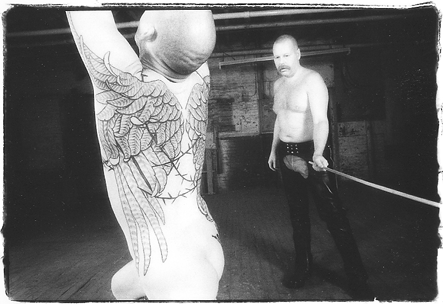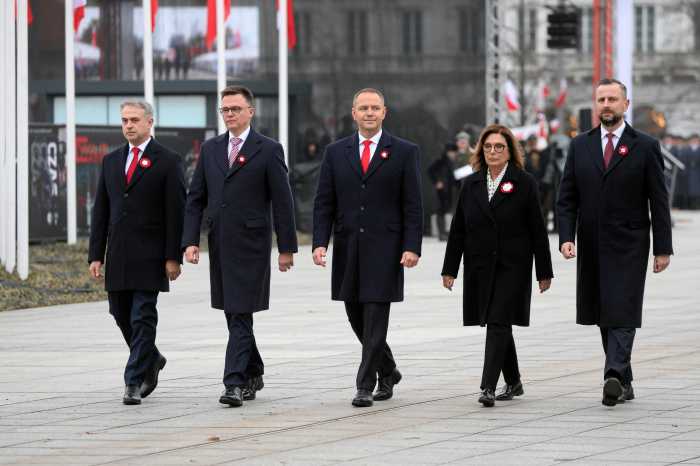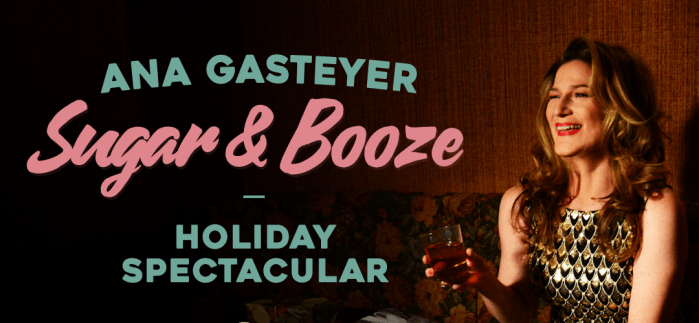Barbara Nitke, photographer and S/M chronicler, on eroticism, justice
“Hi, it’s so great to see you,” Barbara Nitke chirped, her smile beaming beneath chicly coifed, layered, brunette hair, subtly highlighted. The very attractive, well-scrubbed woman’s conservative dress—no makeup, T-shirt, tailored jeans, elegant jewelry, sensible shoes—and friendly, relaxed demeanor might lead one to mistake her for somebody’s really cool soccer mom. Nitke led me into a well-appointed, East Side apartment with framed photos everywhere.
Could this ball of cheery optimism really be a firebrand pornographer who had the balls to proactively challenge the constitutionality of the federal Communications Decency Act, thereby taking on two successive Republican attorneys general—John Ashcroft and now Alberto Gonzales—in order to contest the government’s effort to criminalize and otherwise inhibit sexual speech and images on the Internet?
Absolutely.
This sweet woman, born in 1950 in Lynchburg, Virginia—the heart of Jerry Falwell country—went from small town girl to professional porn photographer to artistic photographer of the less glam, off-camera moments in that industry, and finally became the unofficial official photographer of New York’s bondage & discipline S/M scene. And now this self-described “voyeur,” whose sexually charged images—with gay, straight, and pansexual content, in equal doses and an extremely explicit manner—have shocked many, is planning to take her challenge, rebuffed earlier this summer by a federal appellate court, to the U.S. Supreme Court.
Incredibly, this same woman manages to remain the president of New York’s prestigious Camera Club, a faculty member at the School of
Visual Arts, a working photographer in “straight” industries like law and entertainment, and, last but not least, an acclaimed, successful, working artist.
As Gay City News takes an intensive look at the battle over sexual expression heating up in response to the increased efforts of the U.S. Department of Justice to crack down on what it views as obscenity—a category that could potentially cast a very wide net over adult sexual expression in American society—Nitke sat down to talk about her work and her perspectives on the controversy.
AT: You joined Lesbian Sex Mafia [a women’s SM/fetish group] in ‘95, and TES in ‘94, and you have even served on the TES board of directors and are often their designated, official TES photographer at TES events or other big scene events. Are you involved for the artistic fodder? For the closeness to the subject matter? As a community service? As a supporter of queer and sexual minority rights? As an activist against censorship and for freedom of expression? Or is it more—do you genuinely identify with queer, pansexual minorities? Basically, I’m asking how you position yourself as a self-described “voyeur?”
BN: I identify in a lot of ways as a sadomasochist, even though I’m just a voyeur in the scene. You know, I really think it’s a part of my sexuality. I just express it in my own way. This is a part of me that I’m proud of that I’m exploring and expressing in my own way, and I think that’s what distinguishes my work and makes it great.
AT: You are one of the few women who ventured alone into the inner sanctums of some of New York’s more notorious queer and/or kinky bars and sex clubs gone by. In what year did you start going out to the mostly underground and now mostly vanished clubs like Hellfire, the Vault?
BN: Well, 1994 is when I started and I’m sorry that I wasn’t out there before. I know I missed a lot of great things. But I’ve been to Mother, and I’ve been to the Clit Club, and I’ve been to the Submit parties, I’ve been at Folsom West, and East, of course, the Spike and the Lure, and Paddles, and Hellfire, and the Vault, and the Fetish Warehouse, among other venues. One thing that I’m so sad that I didn’t get to is the Mineshaft, however.
AT: Do you have any feelings or observations on how things changed with AIDS, with generations of sex radicals dying, and with what we now take for granted in terms of prohibitions on sexual activity in clubs as well as new municipal campaigns against New York’s bar and nightlife per se? To what extent do you regret missing the old days?
BN: I always heard about all the stuff that was going on and I’m so sorry I missed out on so much because I didn’t know it was going to end. I was at Hellfire, but not the original Hellfire. The Hellfire that I call home was started in about ‘94, maybe ‘95, and it was on 14th Street and Ninth. And it was preceded by the Vault, which was preceded by the real, original Hellfire. But anyway, yes, I really am so sorry that I wasn’t part of the wild days when everybody could have sex in the open. Who thought that was going to come to an end?
AT: How do you find your subjects? Are your photographs rehearsed, choreographed, or staged, even loosely? How do you get people to agree to display the most intimate and taboo parts of them that become obvious in your work?
BN: Well, the way that I work is I would go to all these parties. And once I started shooting and defined what I wanted to photograph, I was always cruising for people that I wanted to photograph and I would follow them around and beg them. There were many nights when I would be in the bathroom at Hellfire, sitting up on the counter there showing somebody my little 5 by 7 rough prints of pictures I had done and people gradually started to agree to start letting me photograph them. I didn’t direct them, because I wanted them to do what was true to them. And I realized that I often became the third in the scene because what I thought I was going to photograph, starting out, were these incredible moments of intimacy that no one would show anyone else and what they did privately, that I would be a fly on the wall. What I realized very early on is that you can’t be a fly on the wall because your presence changes the scene, and as I got to realize that I realized—I’m part of their scene. They’re allowing me in. This is way more of a privilege than I was even asking for. That’s why I always make pains to say that I’m really an insider. That is, I become emotionally part of the scene. But I do set the boundaries going in, so people don’t think I’m going to all of a sudden jump in with them. They know I’m not going to physically participate.
AT: Do your parents know about your work, about the many objections that have been voiced against it, about your position, however it may be defined, within the B&D S/M, sexual minority community? And did you come out to them or were you outed?
BN: They all know. I was married to a pornographer, which they all knew. I’ve always been the black sheep of the family and proud of it, thank you. They politely don’t discuss most of my activities. [Laughs].
AT: Have they seen your book, or commented on it?
BN: My mom insisted on buying a copy of my book. I couldn’t give it to her. I autographed it to her, and it’s hidden in her house, but she does own it. She’s told me that she didn’t feel comfortable putting it out on the bookshelves or anything but that she wanted to own it. I told them. I’ve never been outed. I believe in beating you to the punch. And in terms of beating you to the punch, I have a very, very dear close friend who is a lesbian, who has always been a role model. So I’m very aware of the whole coming out process and the things that she had gone through. Having had that role model, I always felt that it was important to be able to not have to hide. When I worked on porn shoots as a photographer, I always wanted to let people know, because I didn’t want them to find out. Often I was working in mainstream as well. So I would meet someone and I would say, “Hi, I’m Barbara, it’s nice to meet you, I want you to know I work in porn.” Now that is not the way to come out. Because the person would be looking at me like—this is way more information than I’m interested in, you must be insane. But over the years I’ve gotten it down.
AT: In your straight quote unquote photography world you’re are the president of the Camera Club, you are on various important boards, you’ve taught, you have widely exhibited, obviously there is your book, your freelance living, which includes annual report stuff, mainstream entertainment, law, wedding, and other gigs. Have you ever had any clients react negatively in the more straight, commercial world to your other work?
BN: I lost one client, “Sesame Street.” They’re the only name I want to mention. And I lost “Sesame Street” not in the nicest way, because overnight nobody would take my calls. It took me two years to find out why, until somebody finally told me. And that hurt, but at the same time I think it strengthened my will to say that if you want to hire me, you need to hire the real me, and I’m thrilled to say that they’re the only ones that I’ve lost.
AT: We are here to talk mostly about your work, but we also need to touch on some legal things that are still unclear. These regulations you’re fighting seem to be talking about commercial porn and sexuality sites. How would that affect you as an artist, or any of our readers?
BN: My site is a commercial site. I sell my pictures on my site; I sell my book on my site. There are sites that are not commercial where just a regular person has a little home page and they might have some pictures of themselves and their boyfriend or something. They’re not affected by the [newly announced] 2257 regulations because they’re not commercial sites; but they are effected by the law I’m challenging, the Communications Decency Act, because the CDA says that it’s a felony crime to put obscene material on the Internet, period—it doesn’t matter whether it’s a commercial site or not. Here’s what it amounts to: there are a lot of very far right, radical Christian people who are very, very, very upset about the amount of sex on the Internet. And they have been clamoring for some kind of relief because of all this. So, we’re the opposing view. The claim from the government and the Christian right is that they’re protecting children from pornography. But what they’re really upset about is any kind of sexual expression on the Internet. And someone like me will be very effected because sexual imagery, that’s what my work is all about—sexual relationships, sexual desire, sexual everything—and so if they get pornography stopped on the Internet, they will also stop me and other artists like me. The net result could potentially be that the whole entire Internet will be ruled by what’s proper for a six-year old to look at.
AT: In Topeka. [Both laugh]
BN: Yeah, in a very conservative Topeka community. The whole thing is so complicated that it’s almost designed to make sure that you screw up so that they can fine you and arrest you and whatever so it kind of forces broke people to go out and spend a fortune on lawyers to make sure that we are in compliance. The target is the porn companies, but the other thing it’s going to effect is that there’s going be a ton of gay groups across the country that have Web sites for people to get together, that show imagery, etc. They’re going to sell it to the public on “they’re stealing your children and raping them and abducting them”[laughs] and then it’ll be all the gay people who are really affected.
AT: Just to play devil’s advocate for a second, what in your work justifies, in your opinion, the terrible risk that some 10-year-old could come across your Web site and become traumatized, or that a look at your site for some deeply red state religious people might lead to apoplexy and near heart-attacks?
BN: Well, I think that we should all do each other the same courtesy of changing the channel.
Nitke is currently working on two projects—one, a compilation of her pictures (1982-1990) and writings from her porn industry days, is called “American Ecstasy” and she will soon be in contract with a major publisher. The other, a new B&D S/M photo project highlighting Nitke’s post-2000 photos of couples engaged in extreme transcendent S/M or “edge play,” is tentatively called “Illuminata.”
She is also preparing for her appeal of the July 26 federal appellate ruling against her challenge to the Communications Decency Act.
Nitke’s 2003 book “Kiss of Fire: A Romantic View of Sadomasochism” is available on amazon.com or on her Web site, barbaranitke.com.
Abby Tallmer, who has worked as a librarian and teacher, is a long-time activist for sexual minority rights and against censorship. She can be reached at atallmer@yahoo.com.
gaycitynews.com






































